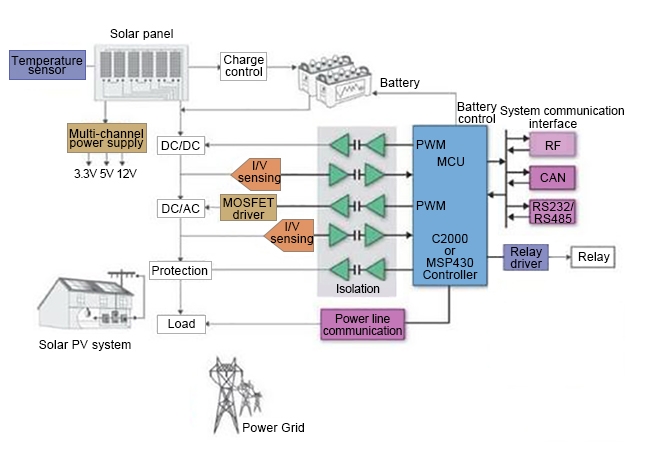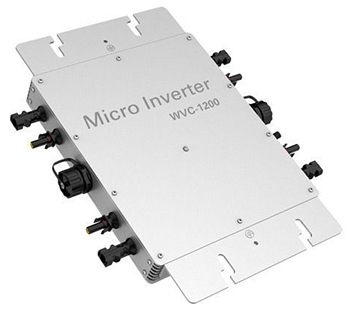Solar photovoltaic (PV) systems have become increasingly popular as a renewable energy solution, offering sustainable power generation while reducing dependence on fossil fuels. In recent years, advancements in technology have led to the development of microinverters, which are transforming the way solar PV systems operate and perform.
What is micro inverter?
Traditionally, solar PV systems utilize string inverters to convert the direct current (DC) generated by solar panels into alternating current (AC) for use in homes or businesses. String inverters are connected to multiple solar panels in series, meaning that the performance of each panel is dependent on the others in the string. If one panel underperforms due to shading, soiling, or other factors, it can significantly affect the output of the entire string.
Micro inverters, on the other hand, are installed directly beneath each solar panel, converting the DC electricity at the source. This means that each panel operates independently, maximizing energy production and minimizing the impact of shading or other obstructions. Micro grid inverters also offer advantages in terms of system monitoring, as they can provide real-time data on the performance of each individual panel, allowing for quicker identification and resolution of issues.
How to optimize?
As to the optimization of the efficiency and reliability for solar PV system, a rather new means is to use micro inverters, which shall be connected to each solar panel. Equipping a separate grid tie micro inverter for each solar panel can make the system adapt to changing loads and weather conditions, thereby providing the best conversion efficiency for a single panel and the entire system.
The micro-inverter architecture can also simplify wiring, which means lower installation costs. By making consumer solar power systems more efficient, the time required for the system to get back the initial investment in solar technology will be reduced.
A key electronic component of the solar power generation system is power inverter. In commercial applications, these components are connected to photovoltaic (PV) panels, batteries that store electrical energy, and local power distribution systems or utility grids. The following figure shows a typical solar inverter. It converts the extremely low DC voltage output from the photovoltaic array into several voltages such as battery DC voltage, AC line voltage and distribution network voltage.

Compared with the entire system using a solar photovoltaic inverter, each solar panel in the system is equipped with a micro inverter, which will once again improve the conversion efficiency of the entire system. The main advantage of the micro-inverter topology is that even if one of the inverters fails, energy conversion can still be performed.
Other benefits of using micro inverters include the ability to use high-resolution PWM to adjust the conversion parameters of each solar panel. Since clouds, shadows and back shadows will change the output of each panel, equipping each panel with a unique micro inverter allows the system to adapt to changing load conditions. This provides the best conversion efficiency for each panel and the entire system.
For example, large-scale solar photovoltaic power plants benefit from communication between panels to help maintain load balance and allow system administrators to plan in advance how much energy is available and what to do with that energy. Please note that the MCU must integrate on-chip communication peripherals (CAN, SPI, UART, etc.) to simplify the interface with other photovoltaic micro inverters in the solar array.
In many applications, the use of micro inverter topology can significantly improve the overall efficiency of the system.
Application Analysis
In small applications, each solar panel may face basically the same conditions of light, temperature, and shadow. Therefore, the role of micro inverters in improving efficiency is limited.
In order to make each solar panel work at different voltages to obtain the highest energy efficiency, it is required to use a DC/DC converter to make the output voltage of each panel unified with the operating voltage of the energy storage battery. In order to reduce the manufacturing cost as much as possible, the DC/DC converter and inverter can be designed into one module. In addition, DC/AC converters used for local power lines or connected to the distribution network can also be integrated into the module.
Solar panels must communicate with each other, which increases wiring and complexity. This is another point of contention over whether to include inverters, DC/DC converters and solar panels in the module. The MCU of each micro inverter must still have enough capacity to run multiple MPPT algorithms to adapt to different operating environments.
In addition to meeting the requirements of the pv micro inverter itself, the MCU used must also handle most of the requirements of the entire system including AC/DC conversion, DC/DC conversion, and inter-panel communication. This can reduce the cost increase caused by using multiple MCUs.
Impact on Energy Production and Management
The use of smart micro inverters has a profound impact on energy production and management, offering several benefits:
- Increased Energy Yield. By optimizing the performance of each panel independently, micro inverters can increase the overall energy yield of a solar PV system. Studies have shown that systems using micro power inverters can produce up to 25% more energy than those using central inverters, particularly in environments with partial shading or varying panel orientations.
- Simplified System Expansion. Micro inverters make it easier to expand solar PV systems. Additional panels can be added without the need for significant reconfiguration of the existing system, making scalability straightforward and cost-effective.
- Improved Reliability and Longevity. Micro inverters are typically more reliable than central inverters. Since they are distributed across multiple panels, the failure of one micro inverter has a minimal impact on the overall system performance. Additionally, micro inverters are often designed to last as long as the panels themselves, reducing the need for costly inverter replacements.
- Enhanced Grid Support. Micro inverters can provide advanced grid support functions, such as reactive power compensation and voltage regulation. These capabilities help stabilize the grid and improve the overall resilience of the electrical system.
Micro inverters represent a significant advancement in solar PV technology, offering numerous benefits for optimizing the performance and reliability of solar energy systems. By operating each panel independently, micro inverters maximize energy production, enhance system reliability, and simplify installation and maintenance. As the demand for renewable energy continues to grow, solar power micro inverters are poised to play a key role in the widespread adoption of solar PV systems, driving forward the transition to a more sustainable energy future.
